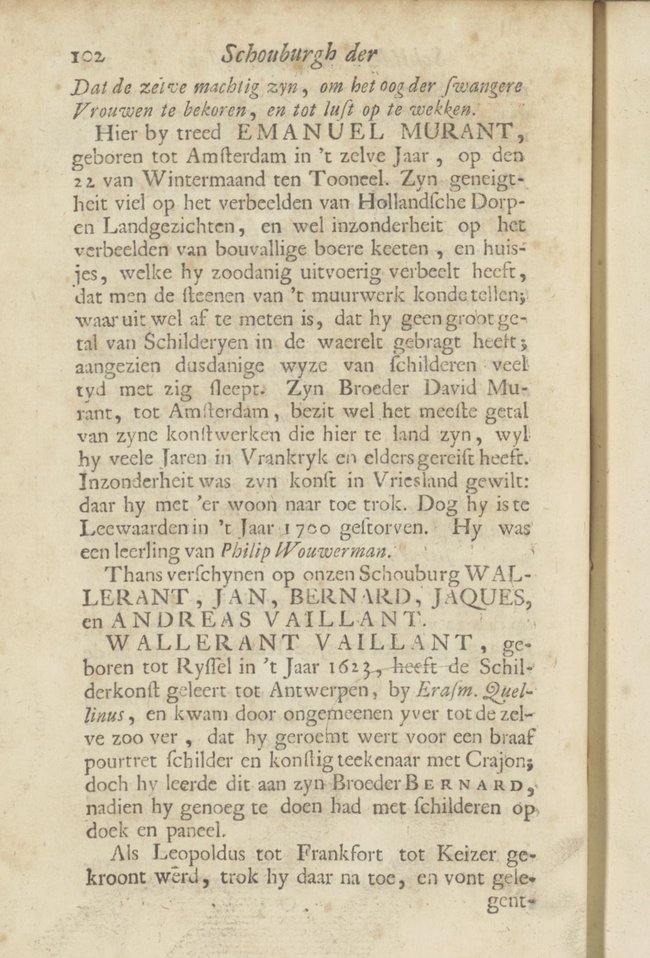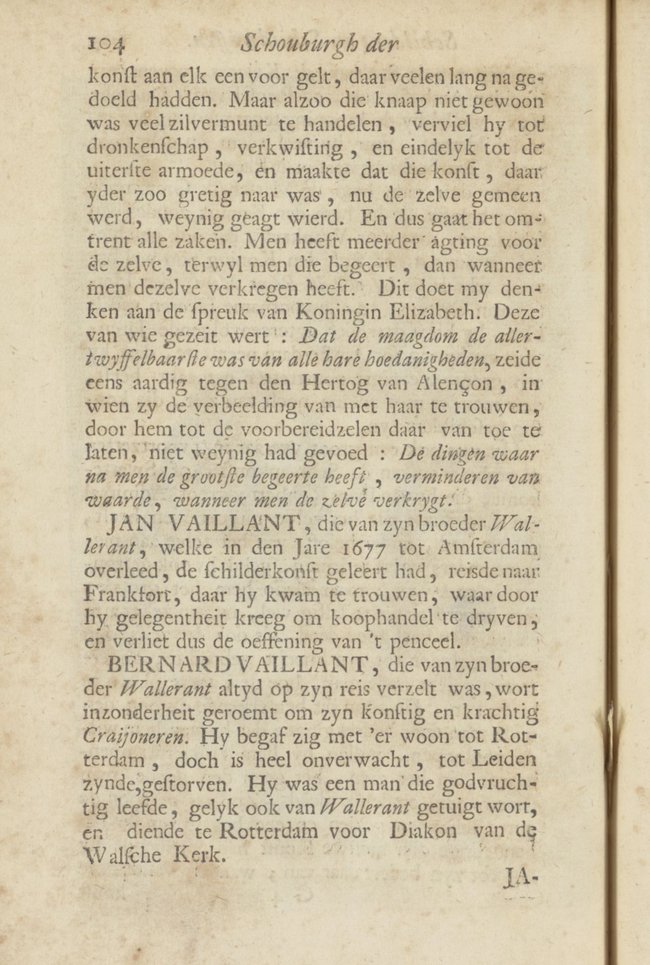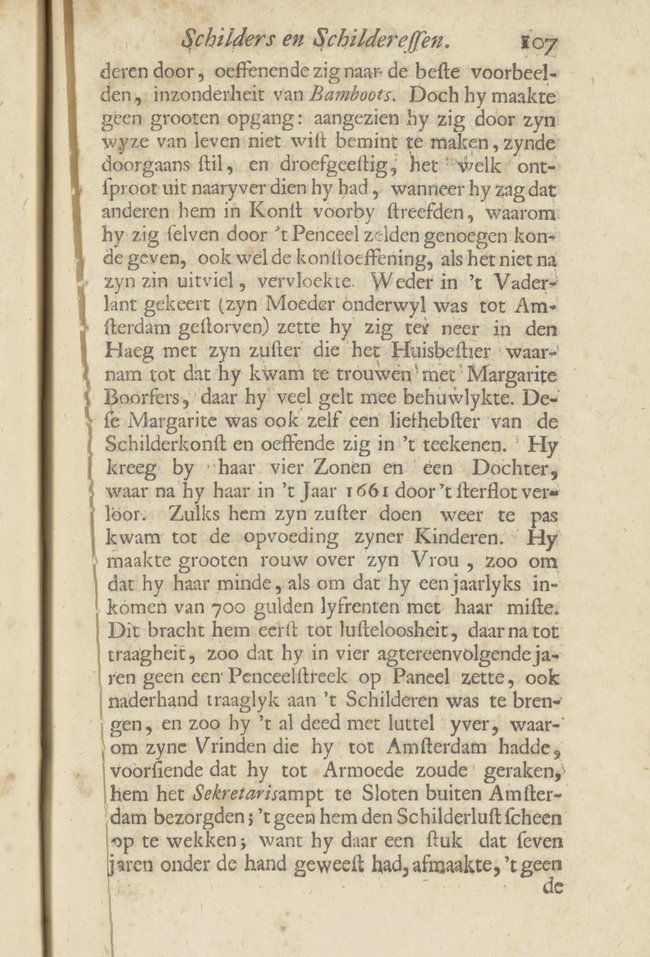Volume 2, page 100-109
Page 100
To what his brush could achieve witnesses particularly a great piece in the anatomy chamber, in which the regents of the guild of wound healers and various city medicine masters are depicted [1]. In various houses in Delft small companies of gentlemen and damsels prove the same.
After him follows the commendable painter
GERBRAND van den EECKHOUT, who was born in Amsterdam on the 19th of August of the year 1621. He was a pupil of Rembrandt van Rijn and to the end of his life stuck to the same way of painting that he had learned from his master, only he has kept the background of many of his art works clearer or brighter. He has in his time painted many life-sized portraits, which he executed artfully and powerfully according to art. Not the least is the portrait of his father Jan Pietersz van den Eeckhout, who was a goldsmith in his time [2]. It hangs with his nephew Gerbrand van den Eeckhout, but he most applied himself to the painting of histories.
I have seen various works of art by him, amongst these one depicting Christ sitting in the temple surrounded by the Hebrew teachers, in whose facial features the effort of teaching and the amazement at the answers of the Lord Christ were so naturally depicted that one seemed to see what they wanted to say to each other [3]. This was an effect for which Rembrandt was particularly famous, so that Eeckhout may be counted amongst the best of his pupils.
Amongst his most important art works is counted a scene depicting Jesus in the arms


1
Cornelis de Man
Anatomical lesson of Cornelis van 's-Gravensande, 1681, dated 1681
Delft, Museum Prinsenhof Delft, inv./cat.nr. PDS 276

2
Gerbrand van den Eeckhout
Portrait of Jan Pietersz. van den Eeckhout (1584-1652), dated 1644
Grenoble, Musée de Grenoble

3
Gerbrand van den Eeckhout
The twelve year old Christ in the temple with the doctors, dated 1662
Munich, Alte Pinakothek, inv./cat.nr. 184
Page 101
of Simeon, with Mister Jacob Jacobsz. Hinlopen, for which the poet Jan Vos has made this caption.
Mary comes to carry her child, her God, as offering.
Thus the temple justice of the old law is completed.
He who obeys the law will please God in everything.
Now one sees what all the world has long waited for,
The longing for one thing appears to consume everything.
It was thus with Simeon, whom we see standing full of joy.
He who is to embrace everything is here by him embraced.
What God promises his people will in time be completed.
The infallible truth comes, even if it seems to take its time.
He has God’s son in his arms and God’s spirit in his heart.
Is it a miracle? No, he has God himself in his thoughts.
The intellect is holy when possessed by God.
Now that he sees life, he wishes to relinquish it.
Man gains eternal life by dying virtuously.
He died, still being single, in the year 1674 on the 22nd of September. We have placed his portrait with his fellows in art in Plate E.1.
JORIS van SON, born in Antwerp in the year 1622, was an artful fruit and flower painter, which gave Cornelis de Bie material to say:
When the trees stand barren and lacking fruit or leaves;
His scene still displays rose and apricot.
And that Van Son knew how to depict these naturally with his art brush, he indicates by saying,

Page 102
That the same have power to charm the eyes
Of pregnant women, and awaken them to lust.
Herewith EMANUEL MURANT, born in Amsterdam on the 22nd of December of the same year, walks onto the stage. His preference fell on the depiction of Dutch villages and landscapes, and in particular on the depiction of dilapidated barns and cottages, which he depicted so elaborately that one could count the bricks of the walls; from which one may gather that he did not bring a large number of paintings into the world, seeing that such a way of painting is very time-consuming. His brother David Murant of Amsterdam likely owns the greatest number of the artworks that remain are here in these parts, since he travelled for many years in France and elsewhere. His art was especially appreciated in Friesland, where he moved with his household. But he died in Leeuwarden in the year 1700. He was a student of Philips Wouwerman.
Now appear in our theatre WALLERANT, JAN, BERNARD, JACQUES and ANDREAS VAILLANT.
WALLERANT VAILLANT, who was born in Lille in the year 1623, learned the art of painting from Erasmus Quellinus II in Antwerp and came so far through exceptional ambition that he became renowned as commendable portrait painter and artful draughtsman with crayons. But he taught that technique to his brother BERNARD when he had enough work painting on canvas and panel.
When Leopold I was crowned as Emperor in Frankfurt, he went there and gained

Page 103
opportunity to paint the portrait of the Emperor [4] and also various ambassadors and princes of the German empire who were present at the coronation. His portrait appears in Plate E. 2.
From there Marshall Grammont [= Antoine III de Gramont] took him to France with the promise that he would have him paint the king Louis XIV [5], which also happened, and because the piece pleased the king so greatly, he also painted the queen mother [= Anne of Austria] [6] and Philippe I, Duke of Orléans [7] and all the important lords of the court. He remained there for four consecutive years, after which he settled in Amsterdam, where he made a great many portraits that are artfully painted and which one still sees quite often.
He was also a great champion of the advancement and improvement of the mezzotint, or black art, which he learned from Prince Ruprecht van de Palts, first admiral of England, who invented it, with the promise not to teach it to anyone else, which promise he kept faithfully. But as the grounding of the copper plates gave him difficulty, and as he did a lot of good for a certain old man and therefore used his son as helper out of pity, he taught this old man how to treat the copper plates. The son, who noticed this, forced the old man with threats that he would run away if he did not reveal and show him the secret, which he finally did (out of necessity). As soon as the son had seen the tools and had a concept of the process of this new art, he helped himself to them to his own ruin, for he auctioned off this


4
Wallerant Vaillant
Portrait of Leopold I (1640-1705), Emperor of the Holy Roman Empire, c. 1658
Dresden, Staatliche Kunstsammlungen Dresden - Kupferstich-Kabinett, inv./cat.nr. C 1980-507

5
Wallerant Vaillant
Portrait of Louis XIV (1638-1715), dated 1660
Versailles, Château de Versailles, inv./cat.nr. V.2014.56.1

6
Wallerant Vaillant
Portrait of Anna of Austria (1601-1666), wife of Louis XIII, 1660
Versailles, Château de Versailles, inv./cat.nr. V.2014.56.4

7
Wallerant Vaillant
Portrait of Philippe I Duke of Orléans (1640-1701), dated 1660
Vienna, Graphische Sammlung Albertina, inv./cat.nr. 15230

Page 104
art (which many had pursued for a long time) to one and all for money. But as this lad was not used to handling much silver coinage, he lapsed into alcoholism, profligacy and, finally, extreme poverty, and ensured that this art, which everybody had desired so avidly, became common and little esteemed. And thus it goes with all matters. People have greater esteem for something while they desire it than when they have obtained it. This makes me thinks of the saying of Queen Elizabeth I. She, of whom it was said: That her virginity was the most questionable of her attributes, once said wittily to the duke of Alençon [= Francis, Duke of Anjou and Alençon], whose pretensions to marrying her she had fed more than a little by letting him make the preparations for the same: The things that one desires greatly, diminish in worth when one obtains them.
JEAN VAILLANT II, who learned the art of painting from his brother Wallerant and who died in Amsterdam in the year 1677, travelled to Frankfurt where he came to marry, by which he gained opportunity to become a merchant and therefore quit practicing with the brush.
BERNARD VAILLANT, who always accompanied his brother Wallerant on his travels, is especially famous for his artful and powerful Crayoning. He went to Rotterdam with his household, but died altogether unexpectedly while in Leiden. He was a man who lived a commendable life, as is also told about Wallerant, and served as deacon of the Walloon church.

Page 105
JACQUES VAILLANT, who also learned art from his older brother, progressed so far by his diligence in the painting of histories that the envoy of Brandenburg, seeing some of his brush works, tempted him to Berlin, where he became the painter of the Elector Friedrich Wilhelm of Brandenburg. The Elector sent him to the imperial court to paint the portrait of the Emperor, who gave him a gold medal with a chain. Returned to Berlin he died and left great fame by his pleasant behaviour and art.
I had almost forgot to mention that, urged on by his wanderlust, he spent two years both in Rome as in other cities of Italy that are famous for the art works of the ancients, and that the bent baptized him as Lark. His portrait appears in Plate E. 3
ANDRIES VAILLANT, after he was also taught drawing by his oldest brother, got the inclination to learn the art of engraving, to which end he let himself be taught for two years in Paris by an important master in that art. From there he travelled to Berlin to visit his brother Jacques and died there in the earliest years of the spring of his life.
The commendable calligrapher Dirck Gijsbertsz. de Bruijn of Amsterdam has the sister [= Clara Vaillant] of these painters as his wife.
Now follows JACOB van der DOES I, born in Amsterdam on the 4th of March of 1623.

Page 106
His father was confidential clerk of the insurance room and his grandfather confidential clerk of the renowned commercial city of Amsterdam. His father, who was an only son and with whom it went as the proverb says, dim-witted mother, dim-witted child, later paid little attention to his situation and went broke though thoughtless exchange speculation. Since the father had died early, it was decided to let our Jacob learn the art of painting (to which he was inclined by nature) with Claes Moeyaert to earn his keep with it. And when in his 21st year, after he had been with him for a few years and could almost fly on his own wings, he went to France and on to Italy. Arrived in Rome he at once met several painters whom he had known in Holland, who welcomed him with much affection and wanted to drag him to the nearest liquor store, which embarrassed him, given that his purse was empty, so that he refused. His friends, who thought this strange behaviour, pushed him with dragging heels into an inn, where he finally revealed the hard truth that he had no money and intended to become a soldier. This was cause for hearty laughter among the Dutchmen, who are not in the habit of leaving their countrymen in the lurch. Thus they encouraged him, asked him to be jolly, made him a bentvogel that same evening, and called him Drum, because he had said he wanted to become a soldier and because he was short of stature (seeing it is customary to use the shortest as drummers). He spent several years in Rome, drawing and painting diligently,

Page 107
practising after the best models, especially Pieter van Lear. Still, he had little success, seeing that he did not know how to make himself beloved by his way of life, usually being quiet and sad, which originated in the envy that he felt when he saw others surpass him in art. That is why he could rarely please himself with the brush and also cursed the practice of art if things did not turn out to his satisfaction. Returned again to his fatherland (his mother having died in Amsterdam in the meantime) he settled down in The Hague with a sister who managed the household until he came to marry Margaretha Boortens, who brought a lot of money into the marriage. This Margarite was herself a lover of painting and practised drawing. He had four sons and one daughter by her, after which he lost her in 1661 to the lot of death. Thus he again needed his sister for the raising of his children. He mourned his wife greatly, as well as her annual income of 700 guilders that he missed along with her. This brought him first to listlessness and then to sluggishness, so that he did not put a brush stroke on panel for four consecutive years. Even then he was slow to paint, and if he did so, it was with little industry, which is why friends of his in Amsterdam, foreseeing that he would end up poor, provided him with the post of secretary of Sloten, outside Amsterdam, which seemed to revive his pleasure in painting. For he finished a piece that had been under way for seven years, which

Page 108
the famous art lover Miss Oortmans [= Petronella de la Court] bought from him for a goodly sum of money, for he had the good fortune to receive better prices during his lifetime than he would get now. He painted several other works during this time which will surely always add to his fame. He also married once more to a Miss [= Johanna Gideonsdr. van Geesdorp] who had lots of money and by whom he had a son, whom he lost to death even more quickly than his first wife. He was at that time acquainted with the commendable painter Karel du Jardin, but when they talked about art they often disagreed with each other, seeing that Karel championed the clear way of painting and he the dark one. Even so they were always good friends, so that after his time of death (which occurred on the 17th of November 1673) Karel was made executor of his estate. He left two sons and a daughter by his first wife and a son by the second one, of which he raised to art only SIMON van der DOES, whom we will commemorate in his turn.
His portrait based on a drawing can be seen in Plate F. 2.
As far as his artworks are concerned, they are known to everyone. I therefore say to his fame that he had wonderfully well understood the choice of light and brown and the combination of animals and that no one excelled over him in the painting of sheep, both in natural drawing as in way of painting.
After him comes the commendable painter DIRCK HELMBREEKER. He was born in Haarlem in the year 1624, but he spent most of his life in Italy, where he

Page 109
also died in the year 1694, being seventy years old. The Romans had great respect for his brush works and esteemed its value next to the art of the brush of Pieter van Laer, which it greatly resembles, and that is the reason why one so rarely sees anything by him in Holland.
The amateur Peter Klock presently has a piece by him that he painted in the year 1681, 13 years before his death. It depicts a cloister built in the Italian manner and before it a crowd of figures of women, men and children, some of them mutilated, who are being given warm food by pilgrims, which is being served to them by a Franciscan brother with a ladle from a large kettle [8]. He himself was diligent in his religion and gave a great deal to the poor.
Here we let follow his fellow townsman and contemporary, the famous painter
NICOLAES BERCHEM. As we learned from his funeral announcement, he died in the year 1683 when he was fully 60 years old, which pointed us to 1624 as his year of birth.
It is said by many that his nickname BERCHEM found its origins on the following occasion. Having long practiced art, with the rays of the dawn of his art spreading everywhere, he developed a plan to undertake a journey by sea, to which end he had not only signed on but had also gone on board. When the mustering of the crew was to begin he was seen by the helmsman (who knew him), who said: What are you doing? Since you are a young man of good prospects and already


8
Dirck Helmbreeker
Soup distribution at a monastery, possibly 1681
London (England), art dealer Whitfield Fine Art

